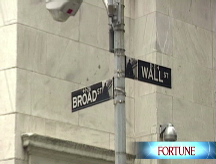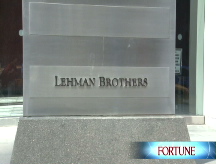The end of Wall Street
As Lehman's demise and Merrill's acquisition make clear, a business model built on ramping up risk and leverage simply doesn't work.
NEW YORK (Fortune) -- Rumor has it that Lehman Brothers CEO Dick Fuld recently wanted to turn off the firm's signature Jumbotron, the giant panels that flash the Lehman name day and night at its headquarters in New York's theater district.
Running the lights, the story goes, was costing Lehman (LEH, Fortune 500) $500,000 a year. But New York City rejected Fuld's plea, since buildings in the Times Square area are required to keep their facades aglow to create the arcade effect that dazzles the tourists.
The lights are still on at Lehman HQ, but they're going out both for the 158-year old firm and for the Wall Street business model that it represents.
Now that Lehman has declared bankruptcy, and Bank of America is buying Merrill Lynch for $50 billion, the ranks of Wall Street survivors have shrunk in the space of six months from five to two, Goldman Sachs and Morgan Stanley.
With Merrill, and Bear Stearns before it, being acquired by giant commercial banks, we're witnessing the triumph of the diversified, universal banking model over the Wall Street one that focused on trading securities and advising corporate clients.
Eventually, the trend will probably capture Morgan Stanley and Goldman as well. Even if they skirt the fate of their former peers, their time is past.
The demise of old Wall Street isn't just about bad bets on mortgages or the hubris of Dick Fuld. It's the failure of an antiquated, risky strategy that depended on macroeconomic luck and that grossly overcompensated employees for being in the right place at the right time.
The game Wall Street played relied on leveraging up the cash provided by shareholders to enormous levels and using all the debt to accumulate a giant portfolio of securities.
As long as interest rates trend downward, the value of that portfolio swells, yielding gigantic returns on a slim equity base. And, with the exception of a few scary blips caused by the Asian currency crisis and the tech meltdown, that's what happened for most of Lehman's existence since it was spun off by American Express (AXP, Fortune 500) in 1994.
Based on a huge surge in profits, the employees arrange to take compensation in amounts unheard of outside of sports and Hollywood.
This model has an obvious, and fatal, flaw. Earnings on Wall Street no longer come chiefly from recurring businesses but rather from a combination of huge leverage and huge risk. When good luck turns, as it did in the credit crisis that began just over a year ago, the shareholder wealth supporting all that leverage gets wiped out.
That's precisely what happened at Lehman. Its shares are trading today at around 20 cents, meaning that outside of the dividend that the firm slashed last week, Lehman managed to destroy wealth for shareholders. The employees, though, took out tens of billions in excess pay that's parked in mansions, yachts and stock portfolios.
How did such a scenario come to pass? There are four key reasons:
Between 2004 and 2007, Lehman swelled its balance sheet by almost $300 billion through the purchase of securities often backed by residential and commercial real estate loans. But in the same period, the firm added a miniscule $6 billion in equity.
As a result, assets jumped from an already high level of 24 times capital, to 31 times. So if the total value of the portfolio declined by 3% or so, shareholders' equity would be erased.
Over the years, once-lucrative businesses on Wall Street have become commoditized, including trading and underwriting bonds for clients.
So Lehman, along with Merrill Lynch (MER, Fortune 500) and other firms, pushed into higher-margin products, notably the packaging and trading of ever more exotic types of mortgage-backed securities. This allowed Lehman and others to keep profits humming. But the shift radically changed their businesses.
Wall Street became far more dependent on proprietary trading and far less reliant on clients. Before the collapse of Bear Stearns, it along with Lehman, Merrill, Morgan Stanley (MS, Fortune 500) and Goldman Sachs (GS, Fortune 500) derived over 60% of revenues from trading, most of it for their own accounts, versus around 40% in the late 1990s.
Wall Street firms evolved into giant hedge funds. Now they're suffering the same fate as a lot of over-leveraged hedgies.
Unlike Bank of America (BAC, Fortune 500) or JPMorgan Chase (JPM, Fortune 500), Lehman and the other independent investment banks don't have a stable base of retail deposits to use for buying securities.
Instead, they rely on short-term debt that needs to be constantly refinanced. That's fine as long as the mortgages and other securities they hold are stable or rising in value and thus easy to sell. But when real estate started to slump, Lehman and its brethren couldn't sell securities they owned except at a big loss.
In the case of Bear, creditors got so nervous about lending money for securities that couldn't be sold that they refused to roll over Bear's commercial paper.
Lehman did have access to a newly created Federal Reserve window for short-term financing. But that couldn't save the firm because the basic problem remains: When markets turn nervous, creditors will stop lending, forcing Wall Street to dump holdings at distressed prices.
Big commercial banks, on the other hand, can hold securities until markets rebound. That gives them a big edge and explains why their model will prevail.
The Wall Street playbook calls for taking home the highest pay possible when times are good and giving none of it back when times are tough.
Since the securities business is cyclical, it would make sense for firms to bank their bonuses forward so that if profits are plentiful one year but disappear the next, part of the compensation is returned to shareholders.
But that's not how the Street works. The pay practices at Lehman are highly instructive. When it came to granting stock to employees, Lehman was incredibly extravagant.
Before Lehman raised equity capital this year, grants of options and restricted stock left 30% of shares in employees' hands. To be sure, employees have lost billions in recent months. But they took out plenty over the years.
Fuld, for example, has cashed out almost $500 million worth of stock in his 14 years as CEO, according to Fortune's Allan Sloan; that's four times Lehman's stock market capitalization as of Monday morning.
In fiscal 2006 and 2007, Fuld earned a total of more than $80 million, an astounding sum for a company Lehman's size. Lehman's general counsel Thomas Russo made more than $12 million in each of those years. Top lawyers for much larger U.S. companies make a fraction of that amount.
Given all of this excess, there's no way this business model can last. The best bet is that Morgan Stanley will eventually be absorbed by a big bank that will reduce leverage, shrink pay scales, fund assets with deposits and impose strict risk controls. That's what JPMorgan CEO Jamie Dimon is doing with the old Bear Stearns and what Bank of America CEO Ken Lewis will no doubt do with Merrill.
Goldman, on the other hand, has the financial strength to move in the other direction and buy a bank. Even so, the Wall Street follies will soon end. They were great while they lasted - though mainly for the hired hands. ![]()
-
 The retail giant tops the Fortune 500 for the second year in a row. Who else made the list? More
The retail giant tops the Fortune 500 for the second year in a row. Who else made the list? More -
 This group of companies is all about social networking to connect with their customers. More
This group of companies is all about social networking to connect with their customers. More -
 The fight over the cholesterol medication is keeping a generic version from hitting the market. More
The fight over the cholesterol medication is keeping a generic version from hitting the market. More -
 Bin Laden may be dead, but the terrorist group he led doesn't need his money. More
Bin Laden may be dead, but the terrorist group he led doesn't need his money. More -
 U.S. real estate might be a mess, but in other parts of the world, home prices are jumping. More
U.S. real estate might be a mess, but in other parts of the world, home prices are jumping. More -
 Libya's output is a fraction of global production, but it's crucial to the nation's economy. More
Libya's output is a fraction of global production, but it's crucial to the nation's economy. More -
 Once rates start to rise, things could get ugly fast for our neighbors to the north. More
Once rates start to rise, things could get ugly fast for our neighbors to the north. More










